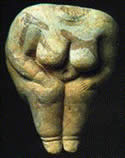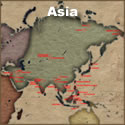The following is an excerpt from the Tattoo History Source Book:
 Arab Religious Tattoos
Arab Religious Tattoos
Evidence of tattooing in Southwestern Asia was discovered in 1930 when painted
figurines about 6,000 years old were found in the Tigris-Euphrates Valley. Sir
Leonard Woolley who discovered them wrote: "On the shoulders of all (the
figurines), both back and front, there are marks which in the painted figures
are in black, the others rendered by small attached lumps of clay; these I take
to be coarse tattooing, like cicatrices of some modern tribes of savages."
|
|
Many 19th century travelers to Southwestern Asia described Arab tattooing. In
1827 J.S. Buckingham wrote:
There are artists in Baghdad, whose profession it is to decorate the
forms of ladies with the newest patterns of wreaths, zones and girdles, for
the bosom or the waist; and as this operation must occupy considerable time,
many "sittings", as an English portrait painter would express it, they must
possess abundant opportunity for studying, in perfection, the beauties of
the female form. |
There is very little information published in English on Arab tattooing. The
most complete work is Henry Field's Body Marking in Southwestern Asia, a survey
that includes tattooing, branding, and the use of henna and kohl. His
information was collected as a result of travels in Egypt, Syria, Iran, the
Caucasus and the area around the Persian Gulf. He believed that tattooing
originated as part of religious rituals.
The Beduoin (nomadic) people and Gypsies (Nawar) seem to be the main influence
on tattoo designs of both Arabic and non Arabic tribes. Bedouin women were the
most heavily tattooed of and were most likely tattooed by the Nawar. The Nawar
tattooed people from Syria, Egypt, Libya, Iran and Iraq right up until the start
of the 20th century.
Traditionally tattooing in Southwestern Asia was practiced by woman, and the
methods were kept secret.
Tattooing was a widespread practice in Iraq during the 1930's. Tattooing is
known colloquially as daqq or dagg, from a root meaning to strike or knock, it
is tattooing by puncture. Tattooing is a custom which was already showing signs
of disappearing in the cities.
Tattooing was rarely done by the upper classes, and is despised by city-dwellers
of the lower classes as well.
In Iraq, tattooing was divided into two kinds: ornamental or decorative.
Generally designs were simple and crude in form. Curative tattooing was done at
the location of the pain or injury, where beautification tattooing (lil-hila) is
more extensive and elaborate.
Curative tattooing was commonly used for sprains but was also used to cure
headaches and eye diseases. The tattooing is applied to the temple or forehead
near the eye. Tattooing is also used for a cure for local skin infection and
pain and against rheumatism.
Magical or Old-Wives Tattooing
There was tattooing that was thought to have magical powers and could induce
pregnancy (usually a single dot or a small design consisting of three to five
dots, applied below the navel, on the back or just above the buttocks.) A dot on
the end of a child's nose ensured that the child's life will be extended. Some
women had a circle of dots tattooed in the shape of a triangle on their palm to
ensure that they would keep her husband's devotion.
Tattoo Museum Bibliography, Resources and Links
 See all South Asian Tattoo Culture Articles here
See all South Asian Tattoo Culture Articles here
NEXT >>
Jewish Tattoos
